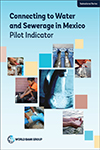Overview
The project entailed developing a methodology for an objective and comparable measurement of the process that an entrepreneur must undertake to connect a commercial establishment to the water and sewerage systems and pilot it across 16 Mexican cities. Although the analysis specifically refers to a commercial establishment, the results are equally applicable to other activities requiring similar water consumption, such as beauty parlors or restaurants. The new set of indicators capture both the efficiency of the process and aspects related to the quality of the services provided by the utility companies and of the regulations governing the process.
Main Findings
- This study finds substantial differences across cities in both the efficiency of the connection process—as measured by the number of procedures, time and cost—and the quality of the provision of water services. While the analysis covers only 16 of the 2,356 water and sewerage utilities operating in Mexico, it suggests the magnitude of the differences faced by entrepreneurs in different locations. Approval processes, inspection systems, the information available and the reliability of supply service may differ substantially even between neighboring cities.
- The cities that have higher-quality supply service also tend to have a more efficient connection process. Not surprisingly, the cities where water utilities have advanced tools and more developed mechanisms for system management also tend to have a simpler and faster connection process. Advanced metering systems, appropriate quality control mechanisms, ongoing communication with the municipality and an updated digital cadastre of the hydraulic infrastructure are all examples of factors that help support efficiency.

